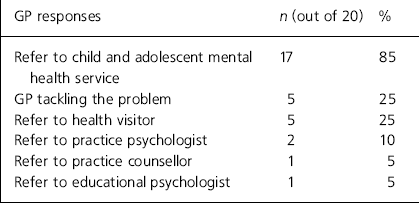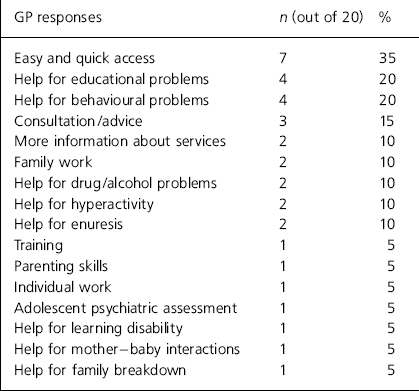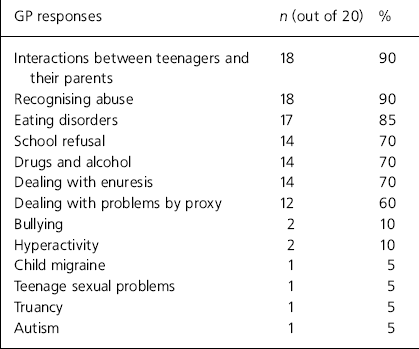Up to one in five children and adolescents suffer from significant psychological distress in any one year. Rates of disorder are highest in inner city areas with high levels of social and economic deprivation (Reference Rutter, Cox and TuplingRutter et al, 1975). However, only a small proportion of children with mental health problems are seen by specialist child and adolescent mental health service (CAMHS). Some children are dealt with by the general practitioner (GP) or other nonmental health specialists such as health visitors, school nurses and teachers, but many go unrecognised. This may be particularly true for internalising disorders such as anxiety and depression and for children and young people presenting with associated physical problems (Reference Garralda and BaileyGarralda & Bailey, 1986 ; Reference Kramer and GarraldaKramer & Garralda, 1998). Children with externalising problems such as conduct difficulties are more likely to draw attention to themselves, but underlying disorders such as hyperactivity may be missed. As most children consult their GP during the course of a year (Reference Garralda and BaileyGarralda & Bailey, 1986), the GP is well placed for early identification of disorders. Recognition and treatment of child psychiatric disorders is important both to alleviate distress and improve overall functioning, but also to prevent subsequent problems in adulthood. Underreferral to child mental health services may result from a variety of factors such as non-recognition of disorders, lack of appropriate training, lack of information about CAMHS, poor communication between CAMHS professionals and GPs, and GPs not valuing CAMHS.
Given the extent of mental health problems in children, the difficulties in identification and the limited specialist resources, an increasing emphasis is being placed on developing links with and supporting nonmental health specialists in primary care settings in recognising and treating disorders, where possible. In addition, with the advent of primary care groups and locality commissioning, GPs will become a powerful voice in purchasing decisions about mental health services. In this context it is even more important that there is ongoing discussion between providers of such a service and general practitioners about the needs of our patients.
A sample of inner city GPs were surveyed on their views of child and adolescent mental health services and on their training needs in this speciality. It was hoped that the process of dialogue would enhance communications with local GPs and that their views could be used to shape the development of local child mental health services and of the training provided to primary care.
The study
Camberwell Child and Adolescent Service is part of the child mental health services provided by the South London and Maudsley NHS Trust. The clinic is based in the community in a health centre and consists of a small multi-disciplinary team of six clinical staff. The clinic operates an open referral system, taking referrals from health professionals, social workers, education staff and self-referral by families. It is the main provider for South Southwark, which includes recognised areas of inner city urban deprivation such as Camberwell and Peckham. South Southwark has a population of around 120 000, 24% being children and young people. This catchment area is served by around 80 GPs, in 25 practices, both group and single-handed. GPs also refer to the hospital-based child mental health services.
A short questionnaire was designed that could be answered in less than 10 minutes. Twenty-five GPs were invited to participate. The interviews were conducted in their practices. They were usually prearranged with the practice managers after morning surgery or before evening surgery. The interviewer, prior to conducting the questionnaire, gave the GP both verbal and written information on Camberwell Child and Adolescent Service. Psychiatric registrars attached to the service carried out the interviews.
The Interview
The interview covered the following areas :
-
(a) How the GP dealt with child and adolescent mental health problems.
-
(b) What services the GP wanted from a CAMHS ?
-
(c) In terms of training, what topics would interest GPs ?
-
(d) Had the GP received any previous training in psychiatry, paediatrics or in child and adolescent psychiatry ?
Findings
Of the 25 GPs, 22 were members of group practices and three were single-handed practitioners. Nineteen were interviewed and one group practice of six returned a single written response. In total, there were 20 responses from the 25 GPs.
How the GP currently deals with child and adolescent mental health problems
Most GPs (85%) refer cases to specialist child mental health services (both community-and hospital-based). Additional information from the interviews indicated that each GP only referred around 1-2 patients a year to child mental health services. Only 25% of GPs dealt with problems themselves and 25% refer to health visitors (see Table 1).
Table 1 General practitioners' (GPs) responses to child and adolescent mental health problems

| GP responses | n (out of 20) | % |
|---|---|---|
| Refer to child and adolescent mental health service | 17 | 85 |
| GP tackling the problem | 5 | 25 |
| Refer to health visitor | 5 | 25 |
| Refer to practice psychologist | 2 | 10 |
| Refer to practice counsellor | 1 | 5 |
| Refer to educational psychologist | 1 | 5 |
What services GPs want from a CAMHS ?
GPs raised a wide range of issues in relation to services. The top priority was easy and quick access to specialist services (35%). Further training was a low priority (see Table 2).
Table 2 General practitioners' (GPs) service priorities for child and adolescent mental health services

| GP responses | n (out of 20) | % |
|---|---|---|
| Easy and quick access | 7 | 35 |
| Help for educational problems | 4 | 20 |
| Help for behavioural problems | 4 | 20 |
| Consultation/advice | 3 | 15 |
| More information about services | 2 | 10 |
| Family work | 2 | 10 |
| Help for drug/alcohol problems | 2 | 10 |
| Help for hyperactivity | 2 | 10 |
| Help for enuresis | 2 | 10 |
| Training | 1 | 5 |
| Parenting skills | 1 | 5 |
| Individual work | 1 | 5 |
| Adolescent psychiatric assessment | 1 | 5 |
| Help for learning disability | 1 | 5 |
| Help for mother - baby interactions | 1 | 5 |
| Help for family breakdown | 1 | 5 |
In terms of training, what topics would interest GPs ?
The GPs were given a menu of topics to select from but could also add other topics. The most popular topics were interactions between teenagers and parents, child abuse and eating disorders (see Table 3).
Table 3 Training topics of interest to general practitioners (GPs)

| GP responses | n (out of 20) | % |
|---|---|---|
| Interactions between teenagers and their parents | 18 | 90 |
| Recognising abuse | 18 | 90 |
| Eating disorders | 17 | 85 |
| School refusal | 14 | 70 |
| Drugs and alcohol | 14 | 70 |
| Dealing with enuresis | 14 | 70 |
| Dealing with problems by proxy | 12 | 60 |
| Bullying | 2 | 10 |
| Hyperactivity | 2 | 10 |
| Child migraine | 1 | 5 |
| Teenage sexual problems | 1 | 5 |
| Truancy | 1 | 5 |
| Autism | 1 | 5 |
Did the GP have any previous training in psychiatry/paediatrics/child and adolescent psychiatry ?
Most GPs (80%) had had previous training in adult psychiatry or paediatrics. None had had formal training in child and adolescent psychiatry but two (10%) had attended brief training sessions on child and adolescent mental health issues.
Discussion
In our sample, rates of referrals to CAMHS by individual GPs were low. This may be, in part, a reflection of an open referral system as children are referred from sources other than GPs. However, on the basis of epidemiological information, only about a fifth of those likely to be suffering from child psychiatric disorders are currently being seen by local specialist services. The low rate of GP referrals may well reflect difficulties in identification in children and young people presenting in general practice. Garralda & Bailey (Reference Garralda and Bailey1986) found that 23% of children between seven and 12 years of age attending general practice were found to have psychiatric disorders, emotional disorder being the most common diagnosis. However, most presented with somatic complaints rather than emotional or behavioural difficulties. This was even more marked in relation to adolescents attending a general practice (Reference Kramer and GarraldaKramer & Garralda, 1998). Thirty-eight per cent were found to have a psychiatric disorders, but only 2% presented initially with psychological problems, the majority presenting with physical problems. Recognition by GPs of the underlying disorders was limited. Garralda & Bailey highlight the importance of GPs probing for emotional and behavioural difficulties, especially in the context of psychosocial disadvantage.
Only a minority of GPs in our sample tackle problems themselves. A proportion refer to health visitors and other practice staff. Most refer to specialist services. This may result from their lack of training in child and adolescent psychiatry. However, pressures on inner city GPs and the lack of time for work of this kind or any additional training may limit their involvement. Adult psychiatric colleagues working in primary care face similar issues. Gask et al (Reference Gast, Sibbald and Creed1997) in their review of models of liaison with primary care, describe tensions between the wish of GPs to refer less severe cases to specialist mental health staff and increasing demands on these staff to focus on patients with severe mental illness. They speculate that the consultation/liaison model whereby a close relationship is built up with the practice to support the development of skills within the practice, may improve the ability of the primary care staff to deal with less severe problems and promote the referral of more severe problems to specialist mental health staff. Ross & Hardy (Reference Ross and Hardy1999) have commented on the need to strike a balance between what can realistically be achieved by GPs in terms of identification, management and referral and appropriate specialist involvement.
Local GPs identified easy and quick access as a priority for them in relation to child mental health services. This is similar to McNicholas' (Reference McNicholas1997) findings in her survey of Irish GPs, with short waiting list times, emergency in-patient provision and written reports being seen as service priorities for CAMHS. There are parallels in adult mental health services with GPs rating a quick effective response by mental health services in an emergency as the most important area of secondary care (Reference StrathdeeStrathdee, 1990 ; Reference WrightWright, 1997).
Subotsky & Brown (Reference Subotsky and Brown1990) describe setting up a monthly child psychiatric clinic in a health centre to increase access to services. The clinic provided assessment services and allowed informalliaison with practice staff. It was well attended but did not reduce the need for a specialist multi-disciplinary base where further work could be carried out. The attachment of a psychiatrically trained health visitor to this clinic, allowed some cases to be treated in the practice. Although there are obvious benefits in terms of access, there are resource implications for small CAMHS teams in offering such coverage to a large number of sites.
Local GPs expressed little interest in further training. None of the GPs had had previous formal training in child and adolescent psychiatry, though most had had training in either paediatrics or psychiatry. It is unlikely that child mental health is seen as a priority for GPs, given the many demands on their time. Local training events in child mental health for GPs have been poorly attended in contrast to the enthusiastic response of general practice trainees. Bernard et al (Reference Bernard, Garralda and Hughes1999) describe the effect of a one session training package on adolescent psychiatry for GP registrars and demonstrate changes in attitudes, skills and knowledge and in clinical behaviour. Following the training, GP registrars were more likely to have a lower threshold for identification of probable child psychiatric disorders. In terms of training topics identified by GPs as of importance, most were areas of obvious concern such as child abuse. It was surprising that teenagers and parents featured so prominently, perhaps reflecting the frustration that GPs are made to feel when drawn into stuck family interactions.
This survey shows a relatively low demand on and limited expectations of child mental health services by inner-city GPs and little interest in developing further skills. The importance to GPs of easy access to specialist child mental health services is emphasised. However, as discussed above, it is likely that there is significant under-identification of child psychiatric disorders, so that though there is a match in some sense between GP demands and limited specialist resources, large numbers of troubled children may go unrecognised and unassisted. The many pressures on GPs and lack of time for consultations and for training almost certainly contribute to this situation. Efforts to improve the interface between primary and secondary care need to take account of these factors. Training may need to be targeted at GP trainees to improve identification of child psychiatric disorders in the longer term. Specific training on intervention skills may be better directed at paramedical staff such as health visitors and practice counsellors. An ongoing dialogue and a better understanding of the different issues facing primary and secondary care services is important in developing new models of care to improve identification and access to help for this group of children. In response to the feedback from GPs, local efforts are presently concentrated on the development of named links at CAMHS to liaise with individual practices and to facilitate referrals into the service.
Acknowledgements
We wish to thank Nigel Blackwood and Catherine Smith for help with some of the data collection. We thank the GPs for their participation.






eLetters
No eLetters have been published for this article.